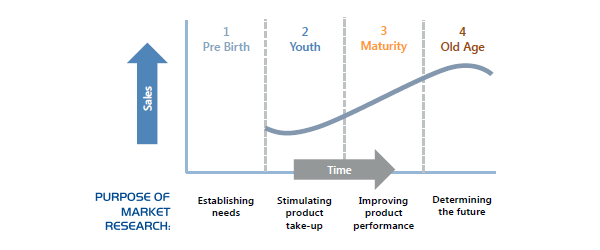At which stage of their life cycle are your products? Be constantly thinking about refreshing and rejuvenating your range. A great goal to shoot for is to have 30% of revenues generated from new products launched in the past three years.

Developing a new product strategy
All products have a life cycle. Understanding where products sit on the life cycle is an important part of developing a marketing strategy. Marketing objectives vary at each stage.

| Pre Birth | Youth | Maturity | Old Age | |
|---|---|---|---|---|
| Marketing Objectives |
Gain trial by early adoption Minimise learning requirements |
Establish market share Establish distribution |
Strengthen market share Build dealer and customer loyalty |
Use product as cash cow Consider product extensions |
| Communications Objectives |
Create wide awareness Generate interest amongst innovators |
Strengthen brand preferences Stimulate wider trials |
Promote frequency of use Suggest new uses for product |
Minimum promotion Maintain brand Create classic niches |
| Communications Strategy |
Personal sales Media advertising Opening offers |
Media advertising Personal sales Sales Promotions |
Media advertising Dealer promotions Sales promotions |
Reduce media expenditure |
A company must ensure that its product portfolio is constantly refreshed so that there is always a breath of new and fresh content for the future. Some people say that 30% of a company’s product line up should be less than 3 years old. “New”, along with “free”, are two of the most powerful words in the marketing vocabulary. Innovations can meet unsatisfied needs and open up unnoticed segments in areas that are right underneath our noses. Our forefathers would have considered it unbelievable that their great-grandchildren would think nothing of paying a small fortune (in their eyes) for bottled water that for most people isn’t any better than water from a tap. We can’t leave the house today without our mobile phones which only 30 years ago were virtually unheard of.
However, much of what is promoted as new is not a radical innovation but a variation on a theme. Walking through the supermarket we can see at least 10 different types of toothpaste, 10 different types of painkillers, and more than 10 different types of breakfast cereal. A tube of toothpaste may scream out at us that it is new but in truth it is very similar to the other nine varieties. However, choice is something we consumers crave and so we encourage products that are different and new.
Some of the big innovations that changed the world have taken years to commercialize. These radical innovations are notably more risky than those that are incremental. The new product itself may not live up to expectations, the market demand may not materialize, and the resource required to develop the new product over a number of years might prove to be too much. Think Concorde, Polaroid cameras, the two dollar bill or the Apple Newton (a personal digital assistant that never made it).
In the 20th and 21st centuries communications have accelerated with the speed of technological change, though even now, a major invention such as a new drug or the electric car can take a number of years before it reaches mass commercialization. James Dyson, owner of the world-beating household appliance business, said: “I spent five or six years developing a completely different kind of vacuum cleaner. I built over 5,000 prototypes to get the system to work. Every year I was getting further and further into debt. In the end I owed something like $4m. I took out two or three mortgages on my house. If I failed, everything I owned would have gone to the bank. Everybody thought I was completely mad.” The development of the Dyson was not an overnight wonder.
There is nothing wrong in imitating good ideas that others have proved. In fact, the risks of mistakes and possible failure are often borne by the first innovation which leads the way for the imitator to build on the foundations of success. A lot of the best business ideas begin as experiments and these are the ones we should keep our eyes on. Market research may help but it is never as informative as a real product trial. Opening a new store concept or launching a new brand will always tell you more than a market research survey that asks hypothetical questions such as “how likely are you to buy X?”. The key to innovation is to find ways to experiment and do things quickly and cheaply enough so that if it doesn’t work out it can be quickly altered or abandoned without too much cost.
The message is clear, we need to build new products into our marketing plan and keep the product life cycle refreshed. We need well-tuned receivers that alert us to the next innovation that will keep our customers interested. We should also be aware that innovation can be as much about the services that are wrapped around the products than about the products themselves.
To learn more about this topic, please visit the following publications:
Using Market Research For Product Development


